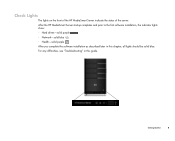

- #Hp mediasmart server ex470 update install#
- #Hp mediasmart server ex470 update 64 Bit#
- #Hp mediasmart server ex470 update upgrade#
- #Hp mediasmart server ex470 update Pc#
- #Hp mediasmart server ex470 update windows#
I now had a mostly-functional copy of Ubuntu Server installed on my MediaSmart. For posterity, add the following to /etc/network/interfaces: auto enp0s4 Once I could log in via USB, I could manually configure the MediaSmart’s native SiS 191 LAN controller in Ubuntu. Then I blind-typed these commands on the MediaSmart with the USB LAN connected there and it worked!
#Hp mediasmart server ex470 update Pc#
I connected it to the good PC and recorded exactly the proper steps to log in and configure Ubuntu to make it work. Presuming that the network chip in the MediaSmart wasn’t detected and configured properly, I decided to try a USB LAN adapter I had in my desk. The MediaSmart gave me no feedback apart from some happy-sounding hard drive noises. Shockingly, this process worked! But the network wasn’t working, so I didn’t know for sure.

#Hp mediasmart server ex470 update install#
I decided to install Ubuntu Linux on the MediaSmart blind, following the steps used on a spare PC. There is a hack to add a VGA port, but the pre-built boards are long-since out of stock and I wanted to get started quicker than building a cable. Although the USB ports support keyboard input, it’s awfully hard to debug the MediaSmart without access to the Sempron CPU’s VGA output. The first setback was a feature, not a bug: The MediaSmart has no graphics port. 1 The original single-core Sempron CPU easily beats the dual-core LIME2 and comes out about even with the 4-core Pi3 overall, though each individual Geekbench test varies widely. Even the Olimex LIME2, with native Gigabit Ethernet and SATA, can’t manage the I/O performance of the MediaSmart. In terms of I/O, there’s no competition: The MediaSmart has native full-speed Gigabit Ethernet and multiple SATA ports, while the Pi still routes all this through a single slow USB 2.0 connection. Why not just use a Raspberry Pi? Apart from the solid chassis and power supply, even the original-spec MediaSmart soundly beats a Pi at just about everything. And there’s no comparison when it comes to Ethernet and SATA I/O performance! I presumed that I could locate these components on eBay (or Weird Stuff)! The HP MediaSmart might have an old single-core x86 CPU but it’s still a lot faster than most ARM boards, including my favorite ARM storage server, the Olimex LIME2 A20.
#Hp mediasmart server ex470 update upgrade#
The stock CPU is a single-core 90 nm “Manila” Sempron 3400+, but the “Brisbane” 65 nm dual-core chip makes a nice upgrade and stays inside the MediaSmart’s meager power and cooling envelope. Some research showed that the MediaSmart’s CPU and RAM could be upgraded somewhat: The MediaSmart uses a standard (if outdated) BIOS and supports 2 GB DDR2 DIMMs and a few different Socket AM2 CPU models. Maybe, I wondered, this little guy could be pressed back into service. The solid chassis is smaller than the three Lord of the Rings books, and the nifty locking hard disk drive carriers are nicer than those found on many servers today. I wasn’t going to take the little MediaSmart until I saw how well-made it was. Although not exactly up to today’s standards, this hardware is decent enough to consider resurrecting.
#Hp mediasmart server ex470 update 64 Bit#
The first single-drive MediaSmart EX470 (and identical dual-drive EX475) featured four 3.5″ SATA disk drive bays, a gigabit Ethernet port, a single-core 1.8 GHz 64 bit AMD CPU, and 512 MB of RAM. Inside Home Server was Microsoft’s innovative Drive Extender software, giving these devices Drobo-like flexibility.
#Hp mediasmart server ex470 update windows#
HP released the first MediaSmart server in 2008, and there was much interest at the time both for the compact yet innovative hardware and the embedded Windows Home Server operating system. This old HP MediaSmart EX480 is out of retirement, with more memory and Linux! Remembering the MediaSmart Here’s how I upgraded the hardware and software. Although it has no graphics, a slow single-core AMD Sempron CPU, and just 512 MB of RAM, I was able to revive it quite satisfactorily. I was recently given an old HP MediaSmart EX470 server along with some other junk hardware.


 0 kommentar(er)
0 kommentar(er)
